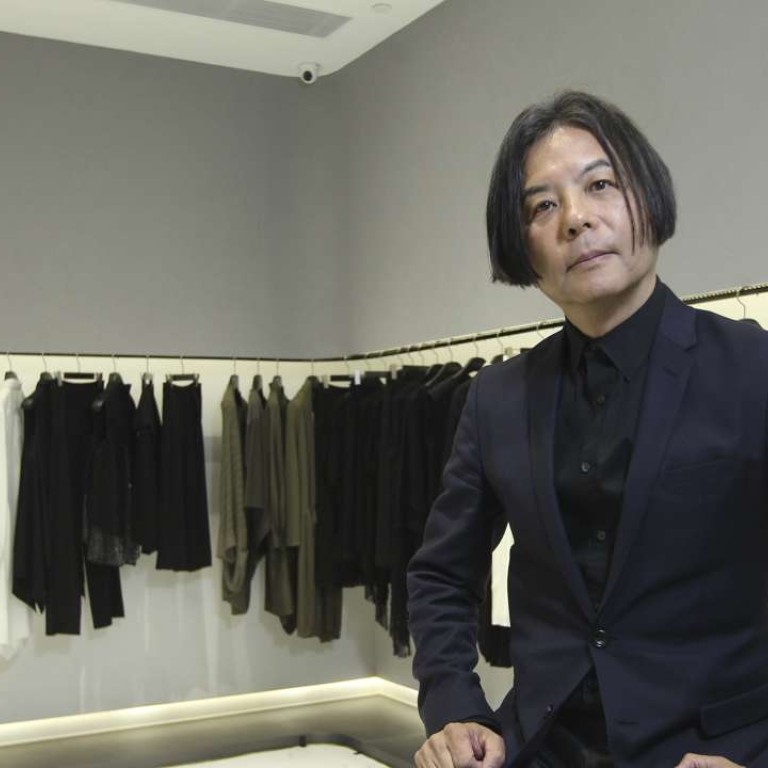
Fashion’s quiet revolutionary, Atsuro Tayama, opens up about his life and style
At 61, Japanese entrepreneur who trained with Yohji Yamamoto and makes mannish ‘but not masculine’ clothes for career women, has written a book about the ideas he lives and designs by
Atsuro Tayama has always had grand ambitions for the clothes he designs.
“I always thought fashion is what I should do, and I have the same intentions now as I did when I started out,” he says, looking back at his 40-plus years in the business. “Regarding fashion, the revolution is the most important thing.”
For Tayama, it’s the detail that’s revolutionary. The 61-year-old runs two fashion lines – Atsuro Tayama and diffusion label A.T. by Atsuro Tayama. He delivers classically tailored collections with a feminine flourish that are shown in Paris and sold around the world.

Tayama graduated in 1975 from the Bunka Fashion College – alma mater of fellow Japanese designers Junya Watanabe, Kenzo Takada and Yohji Yamamoto. He had an extended apprenticeship with Yamamoto’s studio when it was still a small enterprise of just five people. He likens this period to “entering a fashion boarding school”.
After that he branched out on his own and launched his label in Paris. Tayama quickly found the world was keener for him to be a Japanese designer than it was on the idea of him adopting a more Western style.
“When I launched, I intended to be a Parisian designer, so all the elements tended to be quite European. However, people there didn’t like that very much. They thought because I was Japanese I should show my Japanese style and identity in my design. So now it’s an amalgamation of both.” His collections show a European fluidity and femininity and Japanese innovation and precision. His style has often been called “soft avant garde”, a term Tayama himself quietly approves of when I mention it.

“I have my own style,” he says, when asked why it is that his collections continue to hold such appeal. “And those people who come to my shops, they agree with it. It is quite ‘mannish’, that’s always been one very strong element of my core. Mannish, however, is not masculine – it’s kind of feminine but with a little masculine feeling to it.”
Mannish it is, with deconstructed tailoring and a colour palette that mixes monochrome with intense bright splashes. It’s a look that works well for the sort of woman he’s always designed for, a woman who wants to push the envelope a little yet still be taken seriously. “From the very beginning, I designed clothes for career women,” he says. “I myself like this mannish style, and when those ladies come to search for the clothes they like, they may think the mannish style works for them, so they buy it,” Tayama says.

His style is all-encompassing, and fans can see how the pursuit of perfection informs his life in a new book, Atsuro Tayama, My Life, My Style, launched recently in Hong Kong.
“I’d already published one book that had a really good reputation,” he says of his decision to write about his approach to fashion and other aspects of life. “And so this year, I thought I’d give my fans some more. I wanted to show them what my idea is behind making clothes, what the intention of it is, and also what kind of lifestyle I’m living.”

The book provides insights into how he spends his time away from the studio and includes photos of his homes in Tokyo and Kumamoto, which, not surprisingly, are perfect studies in minimalism with furniture and art carefully chosen.
“I’ve always liked the 1930s,” he says. “When war broke out in the early 1940s, all the good things from the 1930s just disappeared in one night, and I wish I could have been a part of those good old days, which was literally the time in which the art movement bloomed and flourished.”
His tastes in furniture also reference the era, featuring Le Corbusier and Pierre Jeanneret chairs as well as pieces by Norman Foster and Philippe Starck. “I take energy and power from pieces of furniture and design in my homes,” he says. “I have a lot of chairs by great masters, they are very well designed pieces of furniture, and I get inspiration from them and use it in my clothes. Every item that’s in my house is not that simple.”

Tayama is at pains to point out his life hasn’t always been like this. “People usually think that because I’m a big designer, I must have always been very gorgeous and rich, but that’s not true. I wasn’t gorgeous at the beginning, and I want people to know they too can develop a business just like me.”
And how do they go about that? “I’d tell them that they should not think about what they like or don’t like, but focus instead on what they’re good and not good at. They should know their strong points and develop those.”
Given the success he has had, one can’t help but wonder what his major strong point is. “Mine is probably my focus on every detail,” he says. “It might start from a very small point, but over the years these tiny details have become bigger and bigger. That’s my strong point.”
